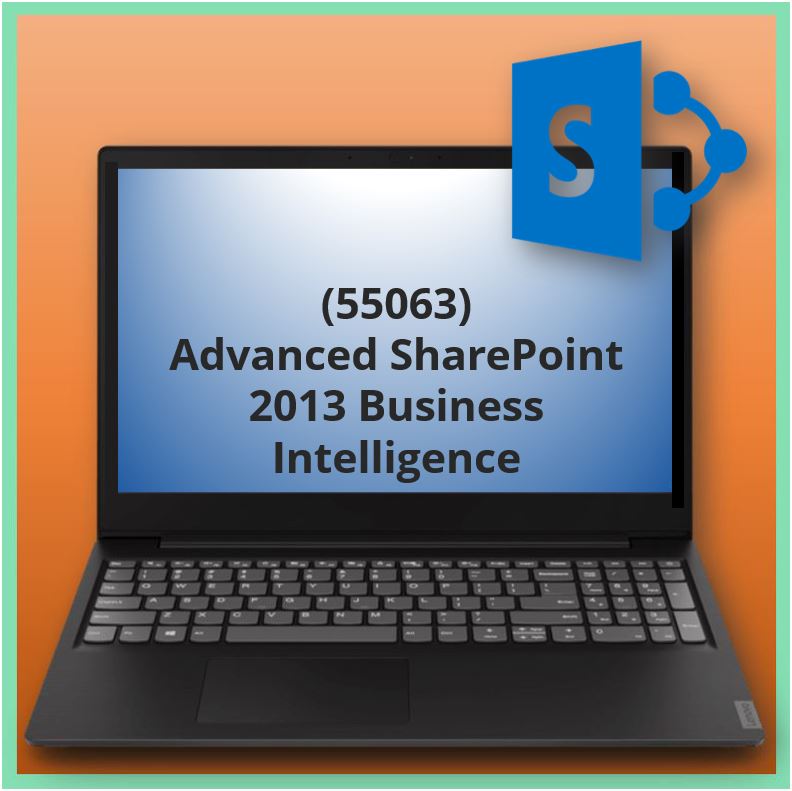Aangeboden leervormen

Advanced SharePoint 2013 Business Intelligence (55063)
Course Description
This course shows how to use SharePoint as your platform for Business Intelligence. Journey through the SharePoint Business Intelligence Center, Excel Services, Reporting Services, Analysis Service, Performance Point and PowerPivot to implement your BI Strategies and enable your decision makers to see data in new and dynamic ways! Also included are Power* features like PowerView, PowerQuery, PowerMap and PowerBI. You will also be exposed to Big Data topics such as Hadoop, HDInsight and StreamInsight. This course will take you down a path of building a BI environment from scratch to full interactive dashboards using the Microsoft BI Stack.
At Course completion
The 2013 refresh of the popular 2010 BI course! This course explores the new design of the Business Intelligence Center, changes in Excel Services and Office Web Apps, Business Connectivity Services and OData, Visio Services, Access Services 2013, PowerPivot, PowerBI, PowerView, PowerQuery and Power Maps, PerformancePoint and Bing Maps via the GeoLocation field. A coverage of Big Data topics like Hadoop, HDInsight and StreamInsight are also included.

Voor wie
This course is intended for Sr. Business Intelligence Architects and Consultants, Sr. Business Analysts, anyone responsible for implementing BI with SharePoint.
Programma
Module 1: Overview
A simple introduction module.
After completing this module, students will be able to:
· Understand your course, classroom, classmates, facility and instructor.
Module 2: Business Intelligence
In this module we review what Business Intelligence (BI) is and what the typical BI goals are. We also explore how Microsoft BI tools are enabling more advanced Business Intelligence features to filter down/up to the decision makers and Information Workers in general.
Lessons
· Why Business Intelligence?
Lab : Business Intelligence Worksheet
· Answer Business Intelligence Questions
After completing this module, students will be able to:
· Define Business Intelligence
· Understand what P=R-C means to BI
· Accept that empowering end users is a GOOD thing
· Understand your BI will only be as good as your data, tools and processes
Module 3: Business Intelligence Center
In this module we are going to explore the Business Intelligence Center site definition that comes with SharePoint.
Lessons
· Business Intelligence Center
Lab : Business Intelligence Center
· Create the Business Intelligence Center
· Explore SharePoint Business Intelligence Center
· Explore Dashboard Designer
After completing this module, students will be able to:
· Navigate and describe the Business Intelligence Center Site Definition
· Understand what a SharePoint Dashboard is
· Understand what integration points are compatible with the Business Intelligence Center
Module 4: Data Mart & Data Warehouses and Master Data Services
In this module we explore what data is and some of the many forms that it takes. We then explore and define the terms Data Warehouse and Data Mart. This module is important in that as we move through the remainder of the course, we will need to have data to manipulate and work with to build our BI components.
Lessons
· Understanding Data and Data Formats
· Building Data Marts & Data Warehouses
· Master Data Services
Lab : Data & Data Formats
· Explore Data Formats
Lab : Build A Data Warehouse
· Create a Simple Data Warehouse
Lab : Extract & Load
· Explore the Extract stage
Lab : Transform & Load
· Explore Transform & Load stages
· Realize the importance of primary/unique keys
Lab : Granularity
· Create Data Warehouse Granularity Levels
Lab : Build A Data Mart
· Create a Data Mart
Lab : Master Data Services
· Configure Master Data Services
· Create Data sources in Master Data Services
· Configure Master Data Services add-in
· Connect to MDS data
· Publish data changes
Module 5: Business Connectivity Services and Secure Store
In this module we are going to take a look at the SharePoint Business Connectivity Services and the SharePoint Secure Store service and how they can help surface external data into SharePoint sites.
Lessons
· Business Connectivity Services
· Secure Store
Lab : BCS Basics
· Explore External Content Types
· Create a new External Content Type
· Create an External List
· Add items to External Lists
Lab : BCS With Data Warehouse
· Creating an Large External List using ECTs
· Using Filters and External lists
· Creating and Configuring Entity Profile Pages
· Enable Revert To Self
Lab : Office & BCS for BI
· Explore Office and BCS Integration
Lab : BCS and OData
· Explore BCS models using OData as source
· Create external list from OData
After completing this module, students will be able to:
· Describe what Business Connectivity is used for
· Describe the new features in BCS 2013
· Describe how BCS integrates with SharePoint features
· How to work with security in BCS applications
· How to change throttle limits of BCS
· How to build new BCS applications
· How security works in BCS
Module 6: Analysis Services, HDInsight and StreamInsight
In this module we will explore the feature of SQL Server called Analysis Services (SSAS). When regular SQL queries can't handle your data, MDX queries in SSAS can. You will also learn about leading edge technologies like HDInsight and StreamInsight.
Lessons
· Analysis Services
· HDInsight & Hadoop
· StreamInsight
Lab : Analysis Services
· Create Dimension and Fact tables with SSIS
Lab : Building An Analysis Services Database
· Create a Analysis Services Database
· Create a Cube
· Create Dimensions
· Create Fact Tables
· Create a KPI
Lab : Key Performance Indicators
· Create Status Indicator list in 2013
Lab : Hadoop and Azure HDInsight
· Install Hadoop for Windows
· Configure Hadoop for Windows
· Export Hadoop data
· Render reports based on Hadoop data
· Use and configure HDInsight
· Install the Hadoop .NET SDK
· Install HDFS ODBC driver
· Build Reports using Excel and Power Query
Lab : StreamInsight
· Install StreamInsight
· Setup demo application
· Write StreamInsight queries
After completing this module, students will be able to:
· Describe OLAP terms
· Understand how to navigate Analysis Services
· How to build a simple cube
· How to write simple MDX queries
· How to use data mining models
· Describe Hadoop and HDInsight
· How to install Hadoop locally
· How to deploy HDInsight to Azure
· Describe StreamInsight
· Install and configure StreamInsight
· Write StreamInsight queries
Module 7: Filter Web Parts
In this module we will explore Filter Web Parts and the important role they play in building Business Intelligence portals.
Lessons
· Filter Web Parts
Lab : Filter Web Parts
· Use each of the Filter Web Parts
After completing this module, students will be able to:
· Describe what Filter Web Parts are
· Work with Filter Web Parts
· Understand how to integrate Filter Web Parts into other BI technologies
Module 8: Excel, Excel Services and Excel Web App
In this module we will explore and work with the various features of SharePoint's Excel Services.
Lessons
· Excel Services
Lab : Create An Excel Report
· Create An Excel Report
Lab : Excel Services
· Learn to use Excel Services
· Create/Publish to Excel Services
· Configure Excel Services
· Shared Data Connections
· Excel Interactive View
Lab : MDX
· Explore Excel MDX features
· Create a Slicer
· Create an MDX Set
Lab : Sparklines
· Use Excel Sparklines
Lab : Filters & Excel Services
· Explore Filter Web Parts and Excel Services
Lab : REST & Web Services
· Explore REST features of Excel Services
· Explore the Excel Services Web Service
After completing this module, students will be able to:
· Understand the difference between Excel Services and Office Web Apps
· Setup and configure Excel Services
· Setup Excel workbooks to use Shared Data Connections
· Use the Excel Services Web Parts
· Use Excel to modify MDX queries
· Use Excel to create Sparklines
· Use Excel Services REST-ful APIs
Module 9: PowerPivot, Tabular Data Sources
In this module we explore the PowerPivot tools of SQL Server and Excel and how they integrate with SharePoint. You will also gain knowledge of a new SQL Server tool called Master Data Services.
Lessons
· PowerPivot For Excel
· PowerPivot For SharePoint
Lab : Use PowerPivot
· Explore PowerPivot Functions
· Use Basic PowerPivot
· Use PowerPivot with Large DataSets
· Create PowerPivot Linked Tables
· Create Slicers
Lab : Integrate Power Pivot and SharePoint
· Install PowerPivot for SharePoint Addin
· Install PowerPivot on Database Server
· Configure PowerPivot for SharePoint
· Publish to SharePoint
· Automating Data Refresh
· Analyzing Usage Data
Lab : Tabular Models
· Create a Tabular Model Project
· Adding Data
· Creating Relationships
· Creating Calculated Columns and Measures
· Creating Key Performance Indicators
· Deploying Tabular models
· Analyzing data in Excel
Lab : Import PowerPivot to SSAS
· Import PowerPivot to SSAS
After completing this module, students will be able to:
· Install PowerPivot on SQL Server and SharePoint
· Configure PowerPivot SharePoint integration
· Create PowerPivot enabled spreadsheets
· Understand the DAX syntax
· Utilize common DAX functions and tools
· Describe Tabular Models in SASS
· Create Tabular Models in SASS
Module 10: Reporting Services
In this module we will explore Reporting Services, its integration with SharePoint and how to build Reporting Services reports.
Lessons
· Reporting Services
· Reports
Lab : Install Reporting Services
· Configure Reporting Services
· Create a Reporting Services Report
· Configure Reporting Services Web Part
Lab : Building Reports with Reporting Services
· Create Advanced Reporting Services report
· Filter Web Parts and Reports
Lab : Automating Reports with Reporting Services
· Create Report Part Gallery
· Create a Report Library
· Create Report Parts
· Create a Report using Report Parts
· Automated Report Delivery
Lab : Reporting Services and PowerPivot
· Setup Reporting Services RSS Feed
· Create and Use Data Feed Library
· Utilize Reporting Services data in PowerPivot
· Utilize PowerPivot data in Reporting Services
After completing this module, students will be able to:
· Describe the new features of Reporting Services 2013
· Understand and describe the integration between reporting services and SharePoint
· Build Reporting Services reports
· Use the Reporting Services web part
· Create Report and Report Part Libraries
· Integrate Reporting Services and PowerPivot
Module 11: Power View, Power Query and Power BI
In this module we explore the new Microsoft BI Stack components available which include PowerView, PowerQuery and PowerBI.
Lessons
· Power View
· Power Query
· Power BI
Lab : Use Power View
· Create PowerView view
· Utilize images in PowerView views
· Create Chart Visualizations
· Create Map Visualizations
· Work with slicers
· Work with multiples
· Work with sorting
· Work with Visualization Filters
· Deploy to SharePoint
· Export to PowerPoint
Lab : Use Power Query
· Install Power Query
· Explore Power Query reports
· Create Power Query reports
Lab : Use Power BI
· Install PowerBI Windows App
· Configure PowerBI
· Working with Power BI in O365
After completing this module, students will be able to:
· Describe Power View, Power Query and Power BI features
· Create Power View reports
· Deploy Power View reports to SharePoint
· Create Power Query reports
· Utilize Power BI for report delivery
· Describe how Power BI works with Office 365
· Setup a Power BI O365 Instance
· Install and configure the Power BI Windows 8 App
Module 12: Performance Point
In this module we will explore Performance Point and how it supercharges your BI Dashboards and Key Performance Indicators.
Lessons
· Performance Point
Lab : Performance Point
· Explore Performance Service Application
· Explore the Dashboard Designer
· Create A Scorecard
· Create A PP KPI
· Explore Time Intelligence
· Create Performance Point Reports
· Create Filters
· Create A Dashboard
After completing this module, students will be able to:
· Describe features and benefits of Performance Point
· Use the new Performance Point Dashboard designer to build reports
· Create Performance Point Scorecards and KPIs
· Use Time Intelligence features in your BI solutions
Module 13: Visio & Access Services
In this module we will explore Visio and Access Services and how to integrate it into your Report process.
Lessons
· Visio Services
· Access Services
Lab : Visio Services
· Use Visio Services
· Publish a Visio to SharePoint
· Utilize data driven Visio diagrams
· Utilize Visio for site architecture diagram
Lab : Access Services
· Access and SharePoint integration
· Removed features
· Publish Access Database To SharePoint
· Explore Access Services 2013
Module 14: GeoSpatial Data, GeoLocation and Power Map
In this module we will explore how to store GeoSpatial data in SQL Server, how to use the new GeoLocation column, the new Power Map add-in for Excel and how to use continue to use the .NET Charts feature from 2010.
Lessons
· GeoSpatial Data
· GeoLocation, Bing Maps and Charts
· Power Map
Lab : GeoSpatial Data with SQL Server
· Populate a SQL Server Database using Shape2SQL
· Utilize the new Spatial Data Types in SQL Server
· Create a Reporting Services Report using Geospatial Data
· Publish Geospatial Data to SharePoint
Lab : Bing Maps and GeoLocation column
· Utilize Bing Maps API
· Create and use GeoLocation columns
· Create a Map View
· Explore SharePoint Store Map Apps
Lab : Use Power Map
· Install Power Map
· Explore Power Map reports
· Create Power Map reports
· Create Power Map Tour and Scenes
Lab : Use Power Map and Power Query
· Create Power Query Report
· Create Power Map from Power Query data
Lab : NET Charts
· Import Chart web part file
· Utilize .NET Charts in 2013
After completing this module, students will be able to:
· How to build geospatial maps using BI data
· How to use the new GeoLocation column in SharePoint list data
· Create and use GeoLocation columns
· Create a Map View
· Explore SharePoint Store Map Apps
· How to install Power Map Excel add-in
· Create Power Map reports
· Create Power Map and Power Query reports
Voorkennis
Before attending this course, students must have:
Understanding of SharePoint 2013 User Interface, database reporting concepts and familiarity with Data Marts and Data Warehouses.
Examen
NVT
Duur training
Open Leercentrum: 5 dagen







